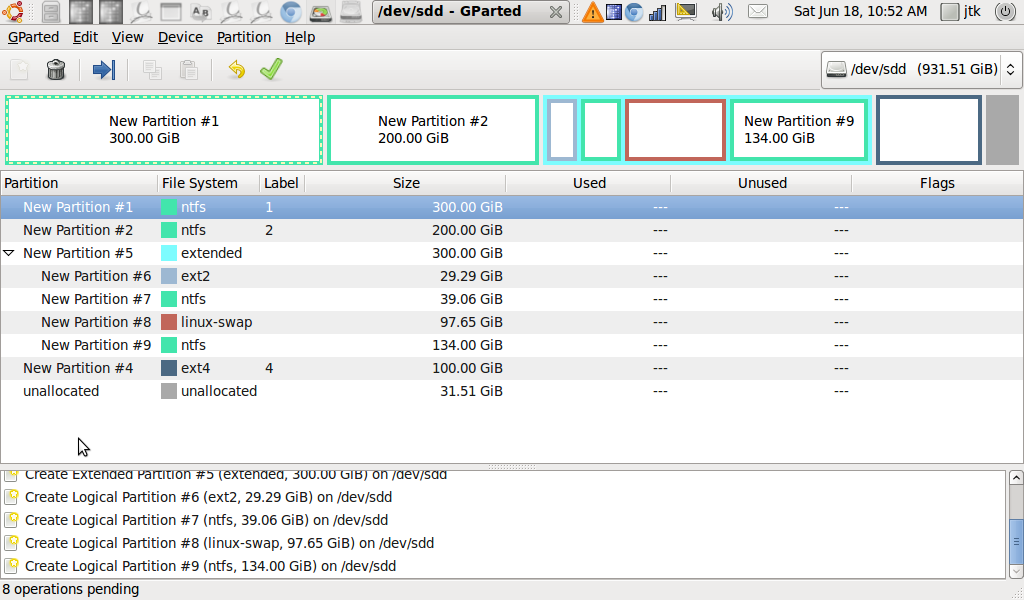This is from a blog article I was writing. The questions are at the bottom.
QUESTIONS
AFAIK, This partitioning scheme has 3 bootable partitions (the three primaries), 1 extended and 4 logical parititions within that one extended partition. Is it true that if you use an extended partition, it (nor any of its logical partitions can be booted from)?
What about linux-swap. I couldn't do an extended partition and make one logical ext4 and the other logical linux-swap? So using linux ext4 (primary) and linux-swap (primary) would take up two of the four primary parititions?
Thanks.
<strong>A Word on Primary/Extended/Logical Partitions
</strong>The difference between primary, extended, and logical partitions, to say the least, greatly confused me. Here's what you need to know. When you partition a drive you have the option of choosing the new partition to be primary or extended.
Primary partitions are partitions
<ol>
<li>from which you can boot an OS</li>
<li> automatically get assigned to a device location</li>
<li> partitioning them must involve the assignment of a filesystem (ntfs, ext4, FAT32, and the like)</li>
<li>have a maximum number of 4 (you can only have 4 primary partitions on any given single hard disk)</li>
Extended partitions
<li>have unlimited count per hard disk (there's no 4 maximum, like with primary partitions)</li>
<li>do not get automatically assigned a device location (nor drive letter in windows)</li>
<li>do NOT get formatted with a filesystem (filesystems are assigned later)</li></ol>
Here's a very helpful diagram from gparted.

Now I made this overly complicated to illustrate the different partitioning types:
<ol>
<li>Partition 1, NTFS, Primary, 300GB,<strong> 1/4 Primary</strong>
</li>
<li>Partition 2, NTFS, Primary, 200GB,<strong> 2/4 Primary</strong>
</li>
<li>Partition 3 (called #5 in diagram), No filesystem, Extended, 300GB, (NOTE: Takes the Place of a primary partition! <strong>Counts as 3/4 primary partition)!</strong>
</li>
<ol>
<li>Partition3-1 (called Partition #6), Logical Partition of partition 3 (the extended partition), 29.29GB, ext2
</li>
<li>Partition3-1 (called partition #7 in gparted, idiotically), Logical partition of Partition 3, NTFS, 39.06GB
</li>
<li>Partition3-3 (called partition # 8), Logical Partition of Partition 3), 97.65GB, linux-swap (it would be idiotic to make the swap partition larger than the linux ext2/3/4 partition but this is just illustrative of primary, extended, and logical partitions.
</li>
<li>Partition3-4 (called partition #9), Logical partition of Partition 3, NTFS, 134GB.
</li>
</ol>
<li>Partition 4 (actually called partition #4 in gparted), ext4, 100GB, <strong>Primary Partition 4/4</strong>
</li>
</ol>
QUESTIONS
AFAIK, This partitioning scheme has 3 bootable partitions (the three primaries), 1 extended and 4 logical parititions within that one extended partition. Is it true that if you use an extended partition, it (nor any of its logical partitions can be booted from)?
What about linux-swap. I couldn't do an extended partition and make one logical ext4 and the other logical linux-swap? So using linux ext4 (primary) and linux-swap (primary) would take up two of the four primary parititions?
Thanks.


